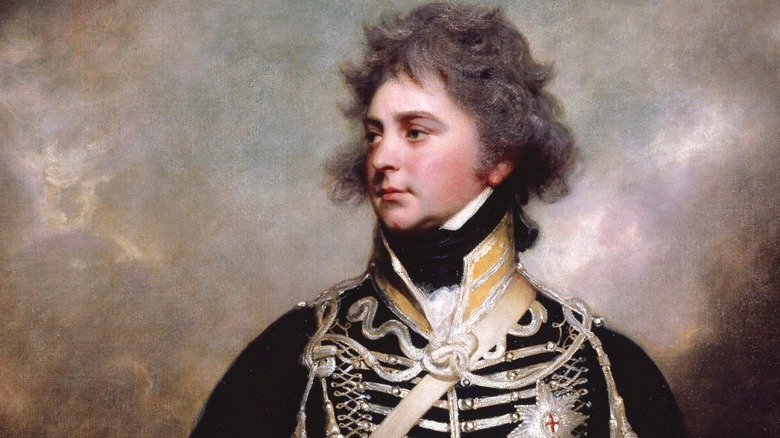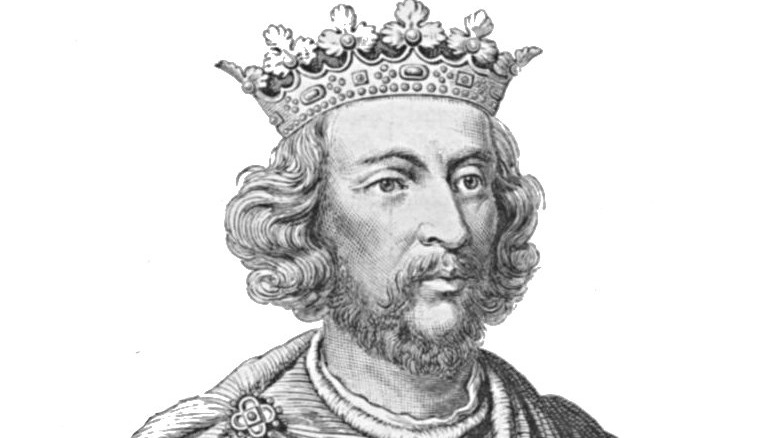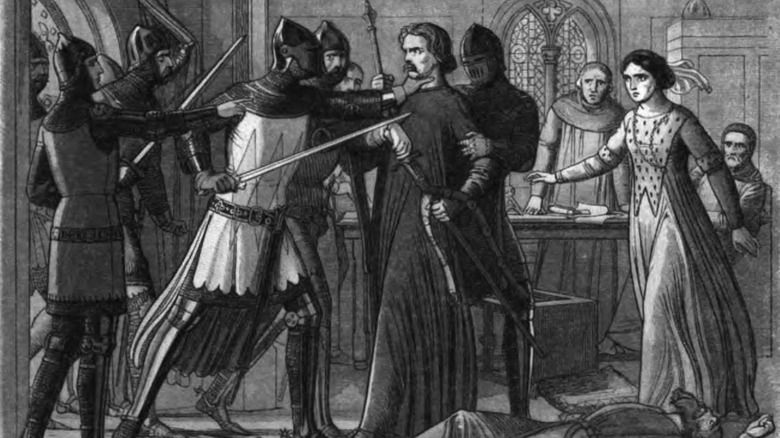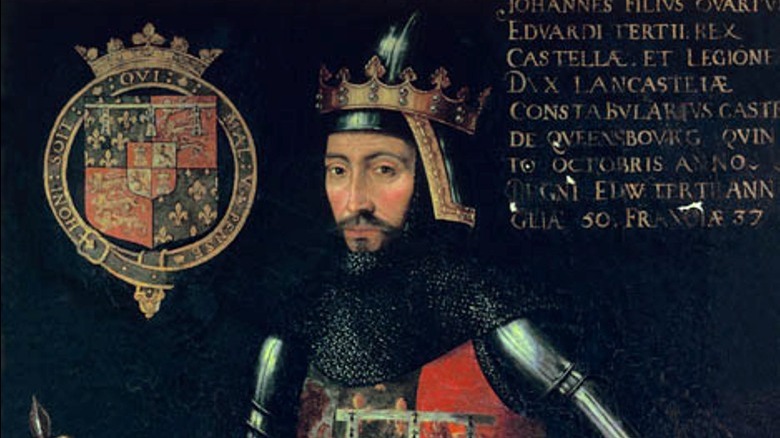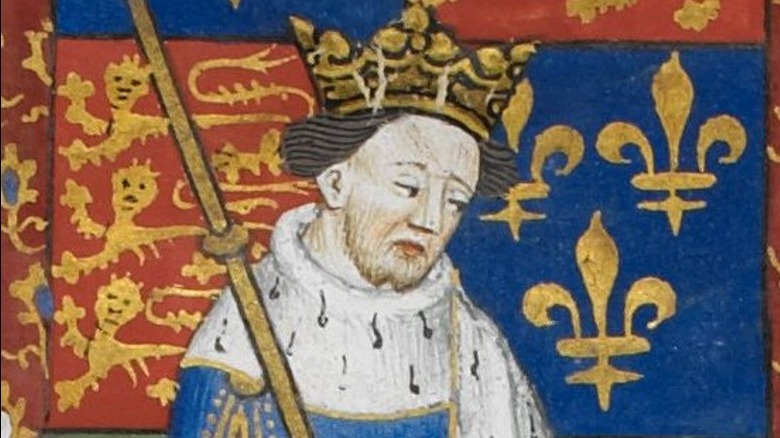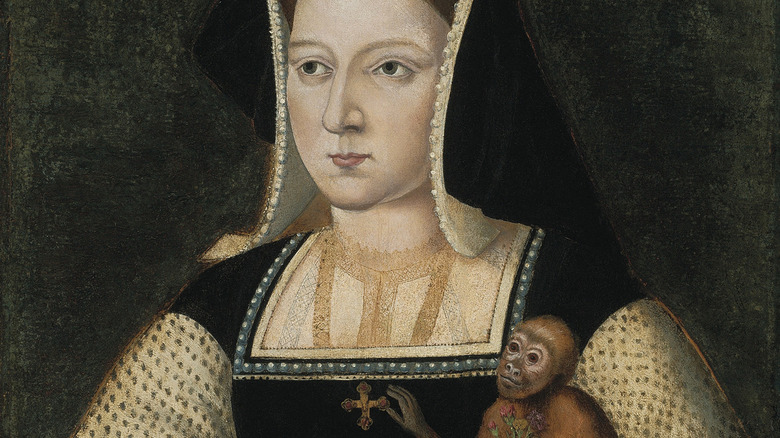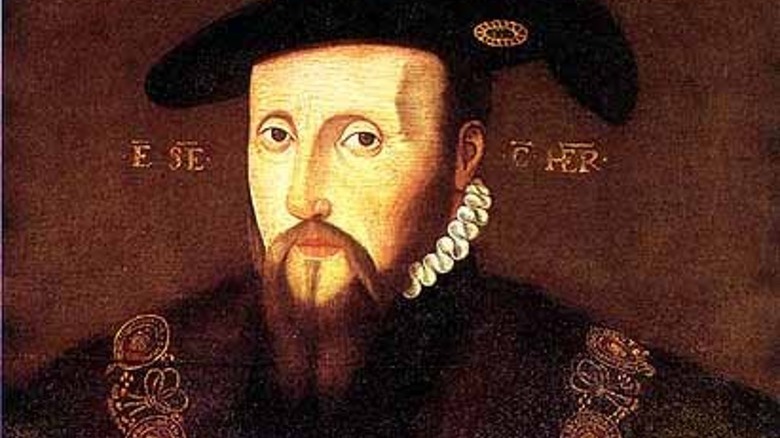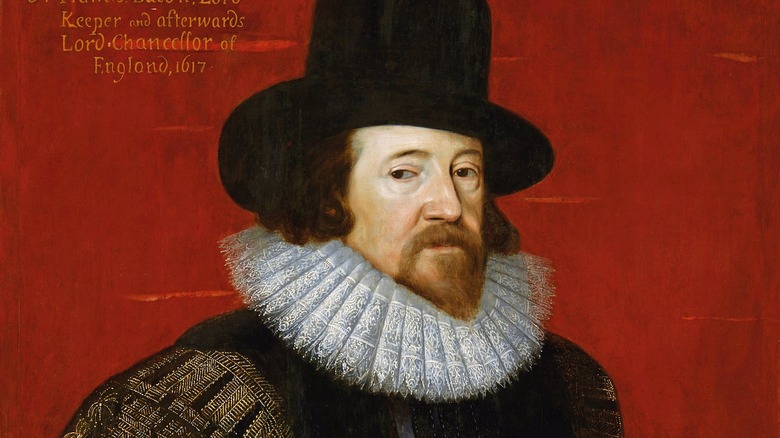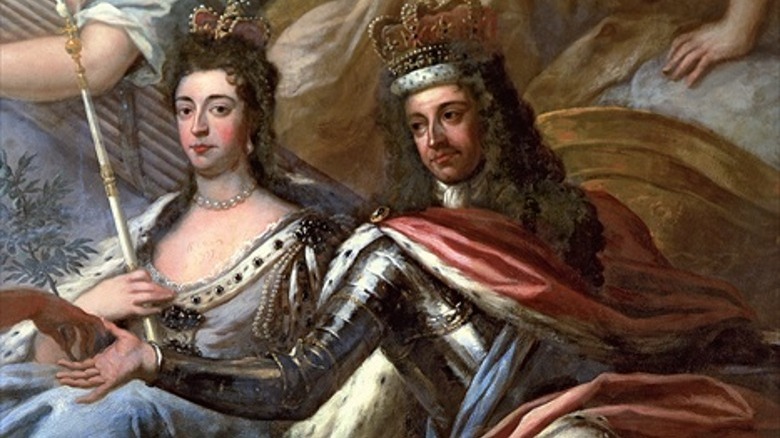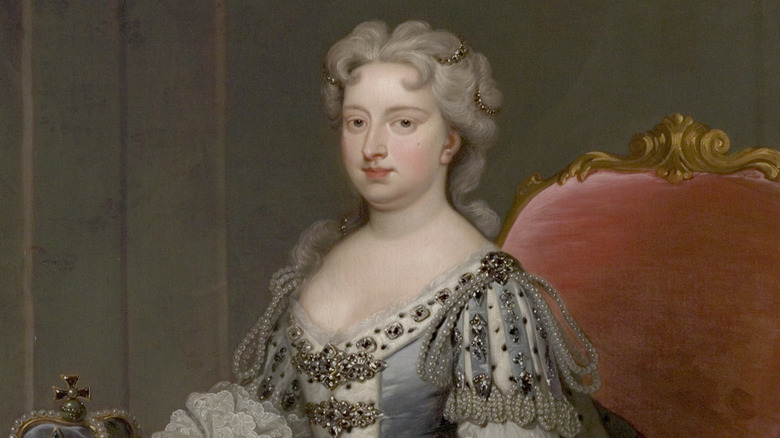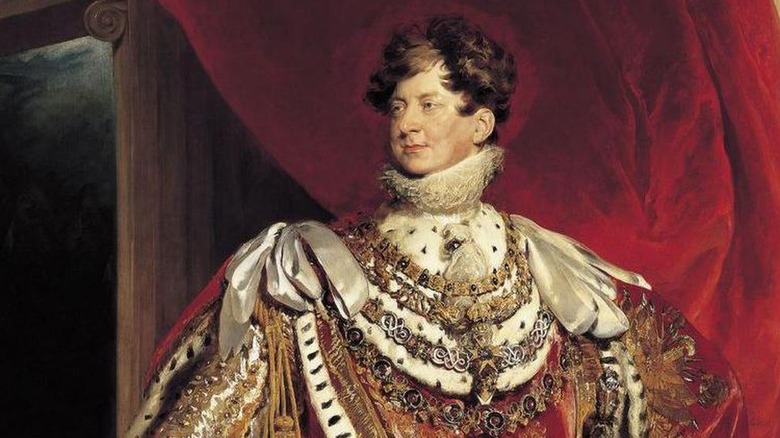Times Regents Notably Took Over The British Throne
The monarchy of England (and then later Great Britain and then the United Kingdom) traces its lineage back to the Anglo-Saxon kings of the 9th century. That's a total of 63 reigning kings and queens over a span of 1,200 years. Given that sizable chunk of history, it's probably no surprise that occasionally something happens to leave the throne vacant even when the monarch is alive — the king or queen might become physically or mentally incapacitated, or they might have to leave the country for war or diplomacy, or, surprisingly frequently, the official monarch is a literal child who should probably not make government decisions.
In such scenarios, the kingdom has appointed regents to rule in the reigning monarch's stead. The kingdom of England (or Great Britain, or Great Britain and Northern Ireland) has seen numerous regents in its long history, some of whom held power for years, and some for only a little while, but who still made their mark on the kingdom. Here are some of the most notable substitute monarchs in British history.
Regents of Henry III (1216-1232)
Henry III of England ascended to the throne in 1216 at the age of 9 following the death of his father, King John. As Henry was still a child, a council was appointed to run the country, led by William Marshal, 1st Earl of Pembroke, who had already served as a marshal, general, and regent for Henry's three predecessors on the throne. Although born to an obscure family, Marshal's great prowess as a knight led him to become the guardian for Henry II's eldest son and general and regent for Richard I and John before becoming governor and advisor of Henry III. The reign of Henry III was marked by rebellious barons in eastern England allied with the French. Being the vigorous soldier that he was, Marshal led the English army against an invasion by the alliance of the French and rebel barons — at age 70! By 1217, Marshal's army had driven the French back to their own shores and ended the baronic rebellion.
Marshal died in 1219, and was succeeded as regent by Hubert de Burgh, who helped re-establish royal authority after the barons' rebellion. He was, however, removed from this position in 1232 when Henry blamed him for a military loss against France, and de Burgh was even put in prison under a charge of treason (but eventually pardoned). Henry took on some Frenchmen as advisors briefly before they were forced back to France by England's nobles. Henry was old enough at this point to rule on his own.
Queen Isabella and Roger Mortimer (1327-1330)
In 1308, Isabella, the daughter of Philip IV of France, married the English king Edward II. However, in 1325, she went back to France with her son, also named Edward, to help settle a matter between France and England. While there, she became the lover of Roger Mortimer, a baron who had been imprisoned for treason, escaped the Tower of London, and fled to France. Isabella, Mortimer, and other exiled barons who had opposed Edward II and his allies returned to England, where they deposed and imprisoned Edward II, who was subsequently murdered in prison in 1327. On paper, the new king was Edward III, the son of Edward and Isabella, but as he was only 14 years old at the time of his ascension to the throne, the real power was his mother and her lover.
For the next four years, Roger Mortimer was essentially the king of England in everything but name, and he used the position to — surprise! — enrich himself. He created for himself the title of the Earl of March and then used that position to claim numerous lordships that had previously belonged to other nobles. Mortimer and Isabella also negotiated an end to the War of Scottish Independence, leading to Scotland becoming an independent kingdom (for a little while, anyway). Because of Mortimer's greed and arrogance, as well as the fact that he lost Scotland, the barons of England convinced the young Edward III to have Mortimer hanged as a traitor. His mother was sent off to join a nunnery.
John of Gaunt and Thomas of Woodstock (1377-1389)
Edward III was succeeded in 1377 by his grandson, Richard II, as his son died before he could take the throne. Richard was only 10 years old at the time of his accession to the throne, however, so the actual management of the kingdom was carried out by his uncle, John of Gaunt, the Duke of Lancaster. In 1381, a series of unpopular labor laws and oppressive new taxes in the aftermath of the hardships caused by the Black Death and the great cost of the 100 Years' War led to the Peasants' Revolt. The rebels, who blamed John for these new policies, destroyed his home, the Savoy Palace, but John himself was not in London at the time and managed to avoid losing his head (literally) to the angry mobs. By the end of the revolt, confidence in Richard as king was up, and John's influence in London was way, way down.
In 1386, John left England altogether because he had married Constance of Castile, a claimant to the throne of Castile in Spain, and John figured this meant he could maybe be king of Castile. (This did not work out.) John's reduction in influence followed by his time away in Spain gave an opening to his younger brother, Thomas of Woodstock, to wrest command of the government away from Richard and execute many of his supporters. In 1389, however, John returned and helped Richard establish peace with Thomas and his allies in time for a now-adult Richard to rule on his own.
Regents of Henry VI (1422-1437, 1453-1456)
Henry VI was only 9 months old in 1422 when his father, Henry V, died, which meant that the governance of the kingdom was actually carried out by his uncle, Humphrey Plantagenet, Duke of Gloucester. The official regent was Humphrey's brother John, Duke of Bedford, but he was too busy fighting the French in the ongoing Hundred Years' War to rule anything. Humphrey was one of the earliest nobles in England to develop a love of the literature of ancient Greece and Rome, and his financial support of humanists in England and Italy led to his being known as "good duke Humphrey." Despite this title, it seems that personally he was unscrupulous and incompetent as a political leader, and so he was constantly at odds with his brother John and his uncle, Henry Beaufort. Humphrey argued that Henry, who was both a cardinal and chancellor of England, should not hold powerful positions in both the church and the government. Nevertheless, Beaufort managed to gain control of Henry VI's government beginning around 1435.
Henry VI assumed full kingship in 1437 at age 16, but he was still a weak and reclusive leader who relied heavily on his uncle's advice. However, despite now being an adult, Henry would once again require a regent when, in 1453, following England's loss of the Hundred Years' War, the king had a mental breakdown, and control of the government was assumed by Richard, Duke of York. Richard's new influence would be a major factor leading to the Wars of the Roses.
Catherine of Aragon (1513)
If you're familiar with the name Catherine of Aragon, it's possible you only know it is the name of the first of Henry VIII's wives, the one he divorced, leading to a split between the Church of England and the Roman Catholic Church. But she was also the wife Henry had the longest — 24 years versus 14 years for his other five marriages combined — and also clearly one he trusted, because when he had to go to war against France in 1513, he left her in charge.
While there was also an advisory council in place, Catherine was hardly just a warm body to keep the throne occupied. With Henry gone in France, Scotland invaded from the north, giving Catherine a chance to show just how active and decisive she could be, which she did gladly. The queen regent assembled troops, purchased artillery and supplies, and — in a move never seen done by a queen before — went to the field of battle herself with an army, where she was able to directly command troop movement while wearing a golden helmet topped with a crown. Following a rousing speech from Catherine, the English troops slaughtered the invading Scots, including their king, Catherine's own brother-in-law. She then mailed a scrap of the Scottish king's bloody coat to her husband in France. While Henry also returned victorious, historians widely agree that Catherine's triumph was the more important one. When Henry decided later to divorce Catherine, he knew she was willing to go to war.
Edward Seymour and John Dudley (1547-1553)
So much of the blood and drama surrounding Henry VIII's various wives was centered on Henry's goal of producing a legitimate male heir to succeed him to the throne. His only legitimate son came from his third wife, Jane Seymour, who died shortly after the baby was born. When Henry himself died in 1547, this son, merely 9 years old at the time, ascended to the throne as King Edward VI. As Edward was still a young child at the time, the administration of government was entrusted to his mother's brother, Edward Seymour, 1st Duke of Somerset. In his role as Lord Protector of England, the Duke of Somerset served as the de facto King of England for over two years. His regency is generally regarded as a well-intentioned failure, with his various attempts to quell enmity between the English and the Scots, as well as Protestants and Catholics, merely creating more unrest.
Following a peasant uprising in 1549, the Duke of Somerset was arrested and executed by John Dudley, 1st Duke of Northumberland, who had been his chief rival in the king's council for years. The young King Edward admired Dudley's strength as a military commander, and so Dudley's influence was so considerable that he managed to marry his son to Edward's cousin, Jane Grey, the king's preferred heir to the throne. When Edward VI died at age 15 in 1553, Dudley attempted to have Jane crowned queen, but Edward's sister Mary overpowered the duke's attempted coup, and John Dudley was executed for treason.
Francis Bacon (1617)
Francis Bacon was a statesman, intellectual, and philosopher, who was the source of the famous proverb "Knowledge is power." Bacon served as a member of Parliament in the late 1500s, but drew the ire of Queen Elizabeth by opposing the increasing amount of funding she was demanding for England's war with Spain. Elizabeth died in 1603, however, and Bacon was able to get into the good graces of her cousin and successor, James I, by explaining how his philosophy and political know-how could help James attain his goals. He was subsequently knighted and then made solicitor general for his role in pushing through the king's plan for a union between England and Scotland.
Due to his constant advice to the king about political maneuvering, especially in regard to interactions between the king and Parliament, Bacon found himself fairly securely in James' favor. And so, when James returned to his native Scotland for the only time in his reign in 1617, he bypassed his own wife — despite her lobbying for the position — to name Bacon as his regent in his absence. Bacon's regency was short (one month) and uneventful, but he continued to earn favor from the king, being appointed Keeper of the Seal and then Lord Chancellor following his regency, and then being made first a baron and then a viscount by 1621. Shortly thereafter, however, he was publicly charged with corruption and legally barred from holding office. He died in 1626 from bronchitis he contracted during a science experiment with ice.
Mary II and William III's Lords Justices (1695–1700)
William III and Mary II of England, previously known as the Prince and Princess of Orange in the Netherlands, were placed on the throne in 1688 after the so-called "Glorious Revolution" in which the Catholic King James II was bloodlessly overthrown and replaced by the Protestant William and Mary. Unlike other monarchs of the English throne, William and Mary ruled jointly. As a result, it was not a regency during the numerous times that William left England to fight supporters of the deposed James II, leaving Mary to administer the government. She was a full reigning queen, but these periods of absence on William's part helped solidify Mary as a ruler in the public eye.
However, despite Mary's repeated solo rule during William's campaigns in Ireland and continental Europe, the queen passed away in 1694, leaving William as sole monarch. As a result, he now required an actual regent when he went abroad. He appointed a council of seven individuals, known as the Lords Justices, to attend to governing while he was gone. These councilors included notable figures like the archbishop of Canterbury, the Keeper of the Seal, and the secretary of state. William ended up leaving the justices in charge for part of the year every year from 1696 to 1700 as he went to deal with the duties he still held in Holland as the Prince of Orange. During one of these absences, William's nephew and heir apparent died, and the crown would pass to the childless William's sister Anne in 1702.
Caroline of Ansbach (1729, 1732, 1735, 1736–37)
When Queen Anne died without children in 1714, the crown passed to her second cousin, a German prince named George, who established the House of Hanover, a dynasty that would rule England for two centuries. George I was succeeded by his son George II in 1727, who had, in 1705, married Caroline of Ansbach, the former ward of the Queen of Prussia. Queen Caroline was known for her intelligence and intellectual curiosity, while George II was, well, not. George was prideful and short-tempered, so it was often necessary for the level-headed Caroline to calm him down and be a moderating influence on his natural tendencies. Caroline's influence included the adoption of more liberal policies held by her former guardian, the Queen of Prussia, and mercy toward rival claimants to the throne from the Catholic side of the royal family.
Caroline was so popular as a governing influence on the king that when George II went to visit Germany in 1729, the queen was named regent rather than their son, the Prince of Wales. This decision drove an even bigger wedge into the already strained relationship between the prince and his parents, whom he hated. All told, Caroline served as regent for her husband four times over the years, and public opinion held that she, not George, was the true monarch of the realm. As a result, Caroline has been considered one of the most influential and powerful queens consort (as opposed to a reigning queen) in the history of the British crown.
George IV (1811-1820)
Out of all the different times that regents sat on the English or British throne, there's one so notable that it's what people mean when they say the phrase "Regency Era": the period in the early 19th century that serves as the setting for Jane Austen novels and "Bridgerton," among other things. This was the time when George IV had to cover for his mentally incapacitated dad for almost a decade. George III officially ruled Great Britain and Ireland from 1760 until his death in 1820. He was the British king during the American Revolution, eventually leading to his depiction as a silly little guy in "Hamilton." By the middle part of his reign, around the 1780s, George III would experience acute bouts of mental illness, characterized by mania, pain, paralysis, and delirium.
While he seemed to recover from his illness for a number of years, by 1811 it was agreed that the king's problems were beyond recovery. The king was handed over to the custody of the queen, and the administration of the government was given to George IV. While the younger George was known in his youth for a somewhat prodigal lifestyle, George IV's decisions as regent were essential to the defeat of Napoleon and the stoppage of his conquest of Europe. When George III died in 1820, George IV officially became king, but his powers and duties were basically what they had already been for a decade. He is perhaps best remembered for his patronage of the arts and influence on fashion.
